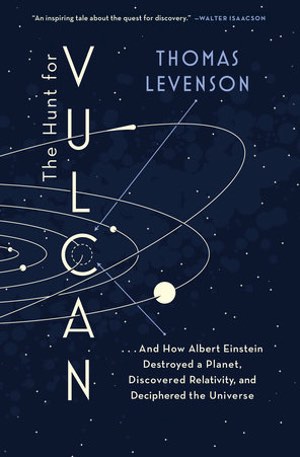Review: The Hunt for Vulcanby Jeff Foust
|
| Vulcan’s theoretical existence, conjured up by astronomers to explain variations in Mercury’s orbit, vaporized when Albert Einstein presented his theory of general relativity one hundred years ago this month. |
But at least both sides of this debate agree on one thing: Pluto does, in fact, exist. That’s in contrast to another scientific debate more than a century ago about another “planet” in our solar system, dubbed Vulcan. Long before Vulcan became associated with the homeworld of the eminently logical species of the same name from Star Trek, the name Vulcan was given to a planet that some astronomers thought orbited closer to the Sun than Mercury. For a time in the latter half of the 19th century, astronomers eagerly searched for it, and some claimed to have seen it as it transited the Sun or appeared in view during a solar eclipse.
Vulcan, of course, does not exist. Its theoretical existence, conjured up by astronomers to explain variations in Mercury’s orbit, vaporized when Albert Einstein presented his theory of general relativity one hundred years ago this month, showing that those variations perfectly his model of spacetime warped by gravity. The birth and death of a hypothetical planet is ably described in Thomas Levenson’s The Hunt for Vulcan, a book that examines, at its heart, what happens in science when theory and observations don’t match.
Levenson starts the book with the development of classical mechanics by Isaac Newton, and refined by others like Pierre-Simon Laplace. That work had demonstrated by the early 19th century that the motions of the planets could be understood and predicted—well, most of them, at least. Towards the middle of the 19th century, it became clear something was wrong with Uranus: observations of the planet’s motion, particularly those predating its discovery in 1781, didn’t match up with what the Newtonian model predicted. Was Newton wrong?
Scientists of the day wagered that he wasn’t: “Better, by far, would be any explanation that captured this seeming anomaly within a Newtonian framework,” Levenson writes, since Newtonian physics worked so well elsewhere. To the rescue was Urbain-Jean-Joseph Le Verrier, who made a series of “almost ludicrously laborious” calculations to show that Uranus’s motion could be explained if there was another, more distant planet. After some effort to convince astronomers to search for it, Berlin’s Royal Observatory looked in the location predicted by Le Verrier—and almost immediately discovered what became known as Neptune. Newton triumphs!
But there was still the matter of Mercury, whose orbit stymied even Le Verrier. The innermost planet’s orbit precessed by an amount that could not be completely explained by the gravitational interactions with the Sun and other planets. Or, rather, the other known planets. If Uranus’s motion could be explained by the existence of a previously unseen planet, perhaps a small planet orbiting closer to the Sun could explain Mercury’s irregularities.
That planet quickly got a name: Vulcan. And, off and on for a couple decades, astronomers reported fleeting glimpses of this planet, but without the certainty of discovery that accompanied Neptune. “The old pattern held: Vulcan was to be found only when it was sought in the faith that it had to exist, never when anyone tried to confirm what had persuaded someone else,” he writes. The last straw, it appears, was a solar eclipse observed in the US in 1878: most astronomers reported no sign of the proposed planet.
| “Decades of attempts to save the Newtonian worldview were at an end,” Levenson writes. “Vulcan was gone, dead, utterly unnecessary.” |
The mystery of Mercury’s motion remained, but for decades was set aside. There was, after all, no way to explain it with the physics known then. It would not be until 1915, when Albert Einstein, already a rising star in physics for his development of special relativity, used general relativity to show how Mercury “follows that warping four-dimensional curve” of spacetime. Einstein showed that, under general relativity, Mercury’s orbit would precess at exactly the rate observed by astronomers for decades.
“Decades of attempts to save the Newtonian worldview were at an end,” Levenson writes. “Vulcan was gone, dead, utterly unnecessary.” While the book’s title is The Hunt for Vulcan, the book is really about the rise of the Newtonian model of the universe, and how scientists, wedded to it because it worked so well, tried to salvage it in one place it did not. They hung onto it until someone—Einstein—came along with a better approach that explained everything the Newtonian model did, and something it could not. Levenson expertly tells this story, without getting the reader lost in too much math or physics. It’s an interesting story in its own right, but also a cautionary tale of how science works.
